The Brazos Review: AMD's E-350 Supplants ION for mini-ITX
by Anand Lal Shimpi on January 27, 2011 6:08 PM ESTDiscrete GPUs on Brazos: CPU and PCIe Bound
Intel's Atom could use a more capable GPU, but what about Brazos? The E-350's GPU is branded the AMD Radeon HD 6310. It has a total of 80 VLIW-5 SPs running at 500MHz. The GPU shares the same 64-bit DDR3 memory interface as the CPU, but it does not have any access to the CPU's caches. Future incarnations of Fusion will blur the line between the CPU and GPU but for now, this is the division.
Branching off the E-350 APU are four PCIe lanes. There are another four lanes courtesy of the Hudson FCH. MSI's E350IA-E45 exposes the former by the way of a physical PCIe x16 slot, although electrically it's only a x4. Curious to see if there would be any benefit to plugging in a faster GPU I decided to try a Radeon HD 5450 and 5570 in the slot:
With a couple of exceptions (World of Warcraft, HAWX), there's no real benefit to a discrete Radeon HD 5450 over the integrated Radeon HD 6310. This is unsurprising as the two have very similar compute capabilities and only differ in the amount of available memory bandwidth since the Radeon HD 5450 doesn't have to share with a neighboring CPU.
The Radeon HD 5570 results were a bit unexpected. Other than Modern Warfare 2 and BioShock 2, there's little performance difference between the 5570 and the 5450 when paired with the AMD E-350. How much of this is due to the performance of the E-350 vs. the bandwidth limitations of the PCIe x4 slot is difficult to say. This smells like a CPU limitation, in which case it would mean that AMD didn't skimp at all when it came to the E-350's GPU.
The Radeon HD 6310: Very Good for the Money
I want to say that lately we've seen a resurgence in the importance of integrated graphics, but I don't know that it ever was truly important. With both AMD and Intel now taking processor graphics seriously, the quality and performance of what we get "for free" should go up tremendously in the coming years. The past two years have shown us that Intel is starting to take GPU performance seriously. The HD Graphics, HD Graphics 2000 and 3000 parts we've been given are all relatively competitive. The only problem is you generally have to spend around $100 - $200 on a CPU to get what I'd consider the bare minimum you should get from integrated graphics. Brazos aims to change that.
The E-350 still isn't enough to play all modern games, but it's what I would consider an acceptable entry level GPU. Despite its stature, the E-350 can easily compete with much more expensive Intel solutions when it comes to 3D gaming. Let's get to the numbers.
Dragon Age: Origins
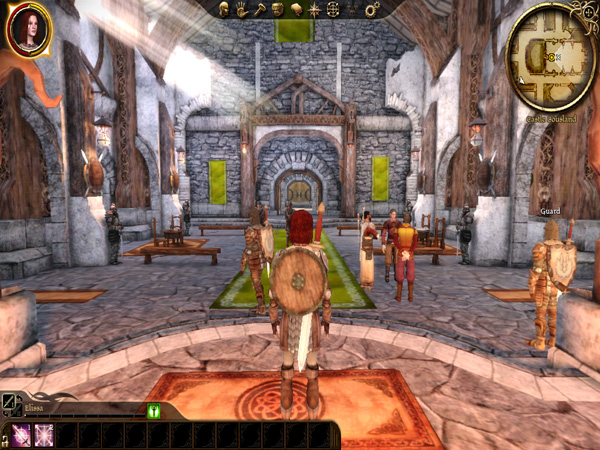
DAO has been a staple of our integrated graphics benchmark for some time now. The third/first person RPG is well threaded and is influenced both by CPU and GPU performance.
We ran at 1024 x 768 with graphics and texture quality both set to low. Our benchmark is a FRAPS runthrough of our character through a castle.
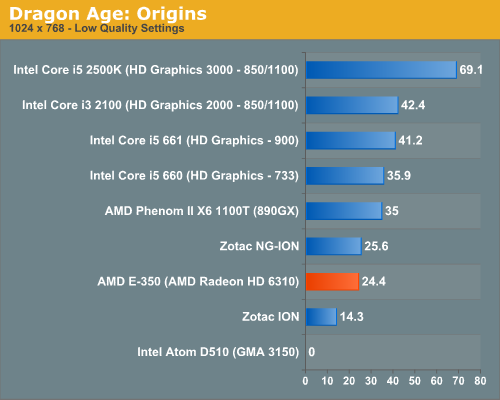
Our Dragon Age: Origins benchmark is quite CPU bound here and thus the E-350's Radeon HD 6310 doesn't look all that powerful. Luckily for AMD, DAO happens to be more of an outlier among current games as you're about to see.
The bare bones Atom D510 won't even run DAO. You'll see a number of games where compatibility is a problem for the D510. NVIDIA's ION does a lot better but it'll take a second generation ION to hang with the E-350. Zotac's NG-ION is actually a bit faster than the E-350, implying some driver/threading efficiencies as we're most definitely CPU bound on these low end parts.
Dawn of War II

Dawn of War II is an RTS title that ships with a built in performance test. I ran at the lowest quality settings at 1024 x 768.
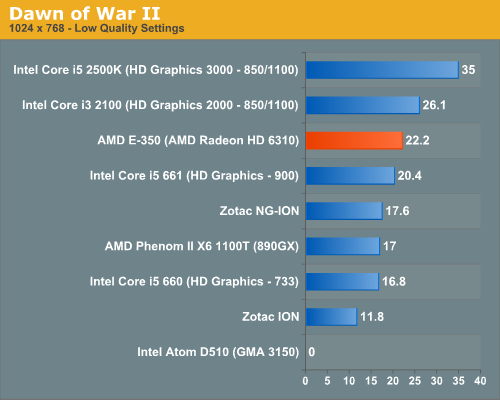
Oh what a difference moving a bottleneck makes. The AMD E-350, with its 75mm2 die is faster than Intel's Core i5 661 - the fastest implementation of Intel's HD Graphics. The E-350's performance isn't too far off the Core i3 2100 either. While none of these frame rates are what I'd call smooth, you can't argue with how competitive the E-350 is here.
Call of Duty: Modern Warfare 2

Our Modern Warfare 2 benchmark is a quick FRAPS run through a multiplayer map. All settings were turned down/off and we ran at 1024 x 768.
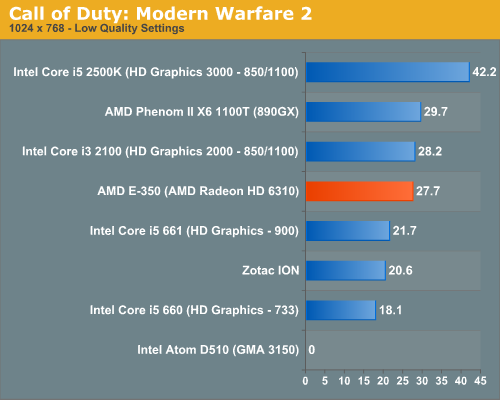
Modern Warfare 2 paints an even better picture for AMD. The E-350 offers virtually the same performance as Intel's Core i3 2100, and noticeably better performance than the Core i5 661. Need I mention that you get this at a much lower price than either of the aforementioned CPUs?
BioShock 2
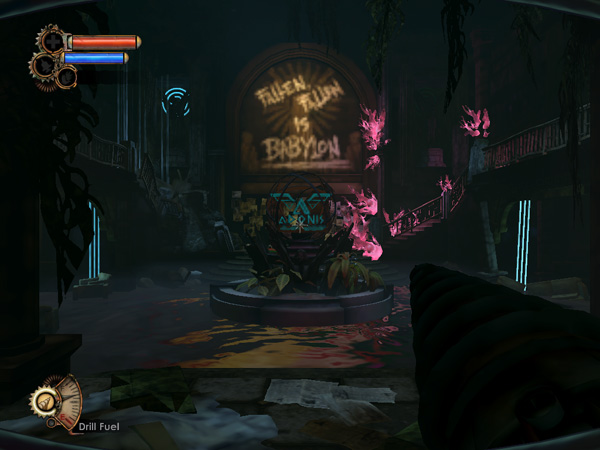
Our test is a quick FRAPS runthrough in the first level of BioShock 2. All image quality settings are set to low, resolution is at 1024 x 768.

Again the E-350 continues to hang with the best here. The frame rates are still not high enough to get excited, but the effort is top notch.
World of Warcraft
Our WoW test is run at fair quality settings (with weather turned down all the way) on a lightly populated server in an area where no other players are present to produce repeatable results. We ran at 1024 x 768.
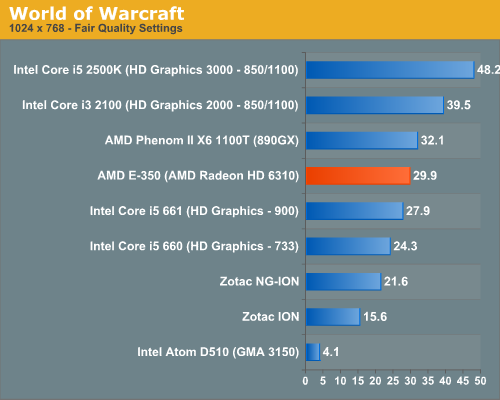
AMD's E-350 is faster than anything from the Clarkdale era, while just a bit slower than AMD's 890GX. Intel's HD Graphics 2000 is faster but at a much higher power consumption and pricetag of course. Intel's Atom D510 can complete our benchmark here but at a laughable 4.1 fps. Both the first and second generation ION platforms fall behind Brazos.
HAWX
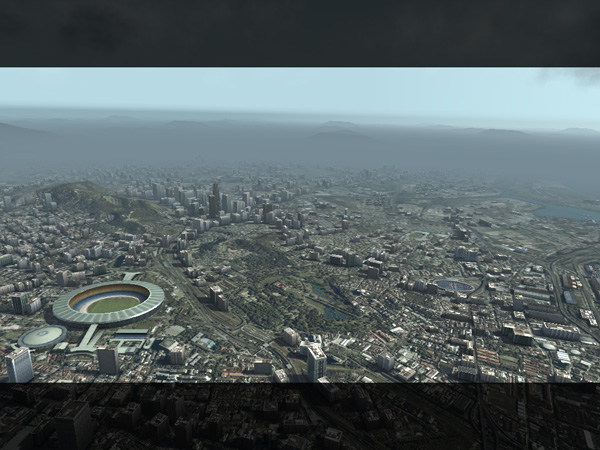
Our HAWX performance tests were run with the game's built in benchmark in DX10 mode. All detail settings were turned down/off and we ran at 1024 x 768.
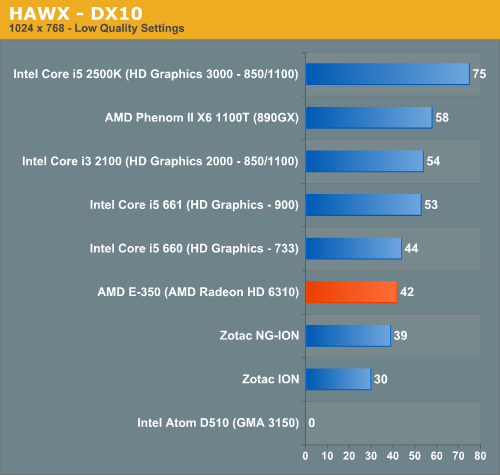
With HAWX CPU performance matters a bit more, pushing the E-350 just slightly behind the Core i5 660. The Radeon HD 6310 still delivers respectable performance in HAWX, especially considering its price point. The next-generation ION does come close in performance to the E-350, while the original ION is significantly slower.
Starcraft II

We have two Starcraft II benchmarks: a GPU and a CPU test. The GPU test is mostly a navigate-around-the-map test, as scrolling and panning around tends to be the most GPU bound in the game. Our CPU test involves a massive battle of 6 armies in the center of the map, stressing the CPU more than the GPU. At these low quality settings however, both benchmarks are influenced by CPU and GPU.
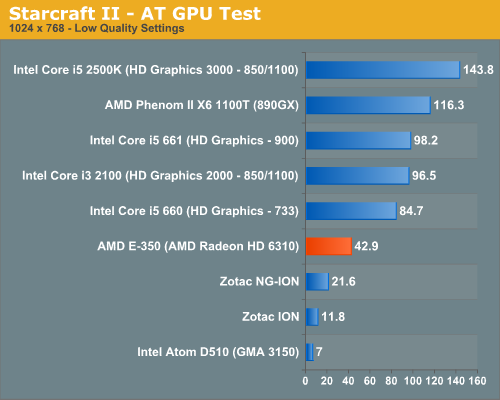
In our GPU specific test, the E-350 is significantly faster than anything Atom based. While the D510 can technically run this test, it does so at only 7 fps. Even the next-generation ION only manages 21.6 fps. The E-350 with its Radeon HD 6310 delivers nearly twice the frame rate of the fastest ION. The advantage isn't purely on the GPU side. As I mentioned before, Starcraft II can be very CPU bound at times. The Bobcat cores at work in the E-350 help give it a significant advantage over anything paired with Atom.
The CPU dependency is what separates the E-350 from its larger, more expensive competitors here. The gap only widens as we look at what happens in a big battle:
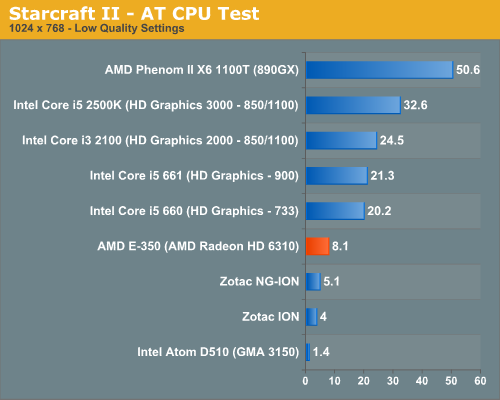
While you can play Starcraft II on any of these systems, to maintain frame rate throughout all scenarios you really need more CPU and GPU horsepower.
Call of Duty: Black Ops
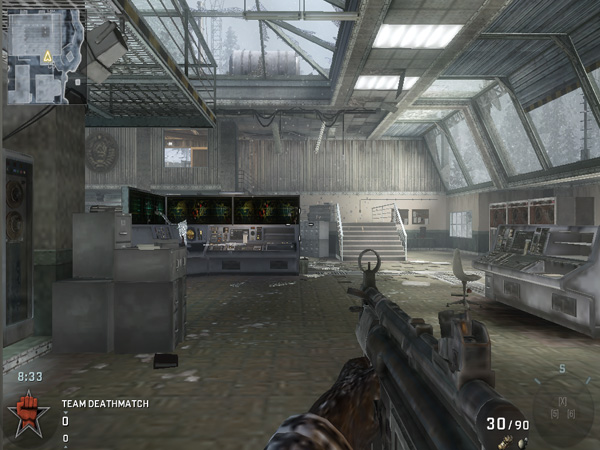
Our Black Ops test is a quick FRAPS runthrough on a private multiplayer server. The game was set to 1024 x 768 at the lowest quality settings.
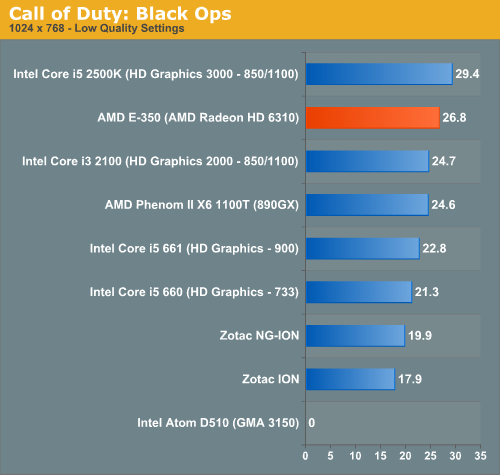
In Black Ops the E-350 does the best it has done thus far, nearly equaling the performance of Intel's HD Graphics 3000. In our Sandy Bridge Review I wondered if Intel was being limited by driver issues here as there's very little difference between the 3000 and 2000 GPUs. The E-350 benefits from all of the driver tweaks and experience AMD has from the Radeon side so it immediately puts its best foot forward. AMD's greatest ally in Fusion will be its driver experience.
Mafia II
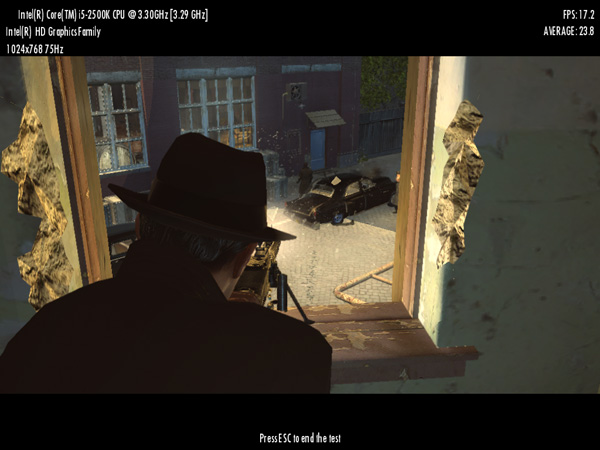
Mafia II ships with a built in benchmark which we used for our comparison:
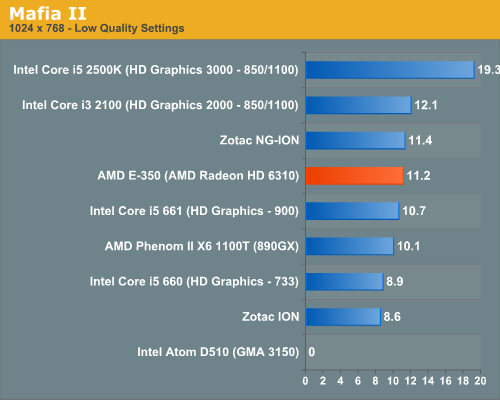
Mafia II doesn't run well on any integrated graphics platform, regardless of vendor. The E-350 does well vs. the competition but none of these platforms are playable, even at the lowest settings.
Civilization V
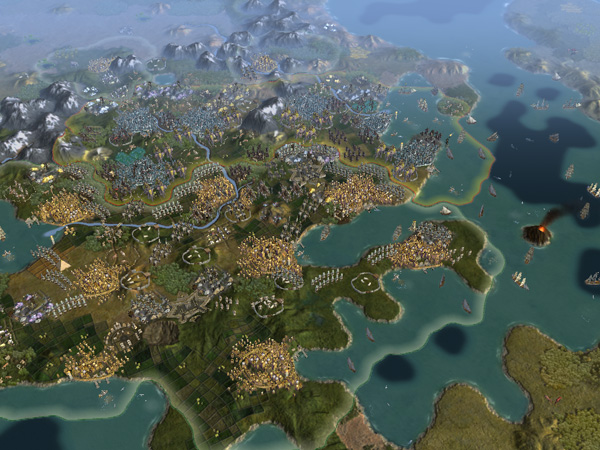
For our Civilization V test we're using the game's built in lateGameView benchmark. The test was run in DX9 mode with everything turned down at 1024 x 768:
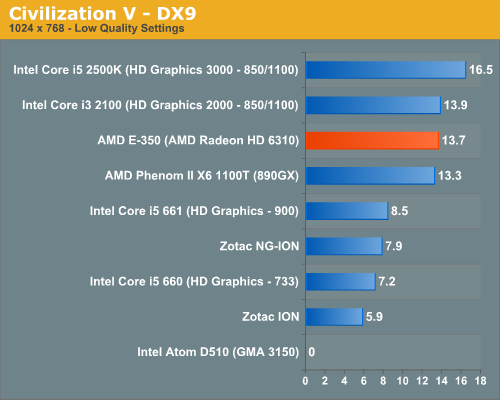
Civilization V doesn't run well on any integrated graphics platform, but the E-350 runs it at least as well (or as poorly?) as Intel's Core i3 2100. The Bobcat cores help with a lot of the heavy lifting here giving the E-350 a substantial lead over Atom.
Metro 2033
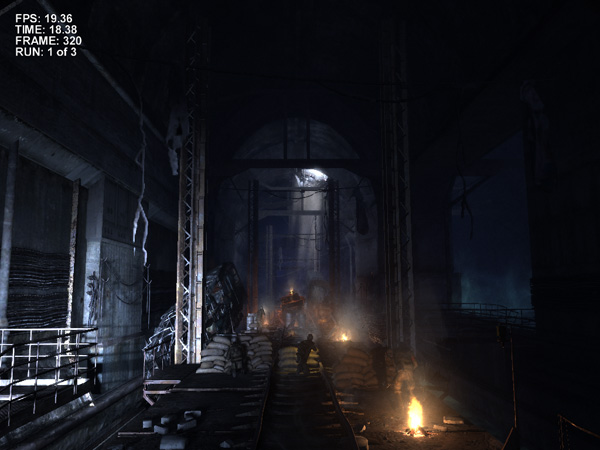
We're using the Metro 2033 benchmark that ships with the game.
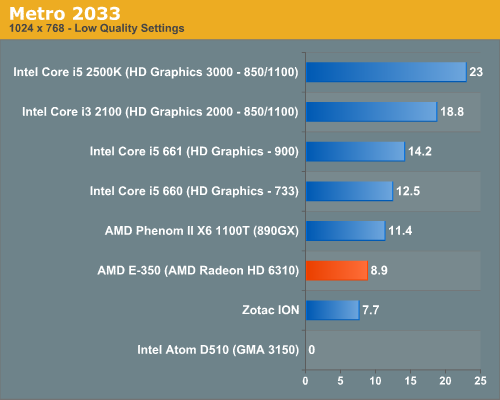
Metro 2033 is a bit too modern for these low end platforms. The E-350 is faster than ION but not in the realm of playability.
DiRT 2
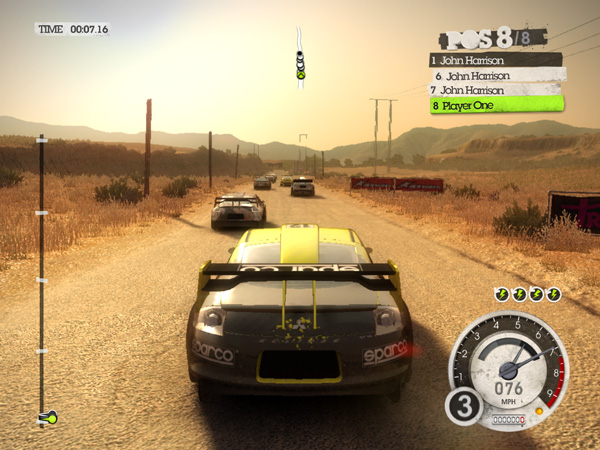
Our DiRT 2 performance numbers come from the demo's built-in benchmark:
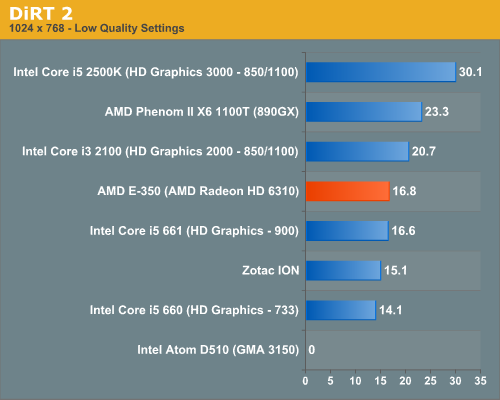


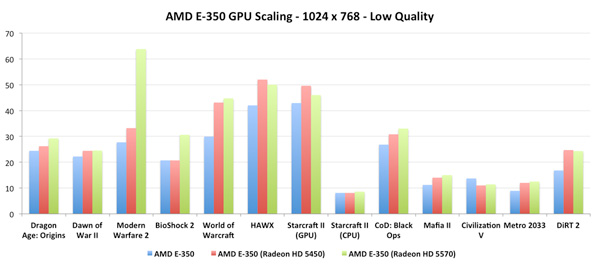








176 Comments
View All Comments
nitrousoxide - Thursday, January 27, 2011 - link
That's cool. When Intel owned everything, try buy a Core i5 with $200 as today. Actually, I'm not quite sure if an i3 will cost less than $150.And that's what happened during G80 era. nVidia has the best GPU, much much faster while the R600s are craps, ATI's on the edge of extinction. See what you got? $1000 for the flag-ship 8800 Ultra, $600 for a high-end 8800GTX. A decent card may cost you $400 (8800GTS) and even a crappy (though not as slow as Radeon 2600) 8600GT costs you $250.
Enlightenment777 - Thursday, January 27, 2011 - link
Rumors, Rumors, Rumors, Reviews, Reviews, Reviews, when can we buy E-350 motherboards from NewEgg?GTaudiophile - Thursday, January 27, 2011 - link
What are the differences between high- and low-end HTPCs?I am thinking of making a combo HTPC/NAS box of sorts...playing the role of both media streamer (online content, mkvs, etc.) as well as a storage box for machines on the network.
Will this do it? With what OS?
djfourmoney - Thursday, January 27, 2011 - link
Go to the AVS Forums and look at Rene's HTPC Guide, the latest version is $10 but well-worth it.Low End HTPC especially AMD in recent years rely on IGP for all video decoding. But this equals the performance of a 785/880 based CPU/Chipset combo and cost about 25% less, less than half the power needed and tiny footprint.
Unless you need expansion slots, as I said this thing can be built for such a low price you should replace your standard def Cable Box with this. Even with a PCIe Tuner Card that read Clear QAM as most do, it will pay for itself (no box rental fee) in about a year if not less.
You can not buy a i3 for less than the whole board. In fact for the price of a i3, you can get the Asus with Wifi, Bluetooth and Heat Pipe cooling which is going for 141 Euro listed on European sites. It should cost roughly the same in the States some sources have it coming in around $150.
Even if that's the case if you don't need USB 3.0 or SATA 3.0, the ASRock and Jetway boards will be the cheapest and think should be under $100 street price.
Too bad AMD's current drivers don't support HDMI Audio for Linux installs. If they ever solve that, then you really can build a sub-$325 with all brand new parts.
Just to fully answer your question, a high end HTPC depending on your desires, will have a Core i5 or AMD Phenom II CPU and Mid Range Video Card (HD5770) for some post-processing and 7.1 over HDMI. You can do that or a $200 Asus Xonar card, the GPU is cheaper and will do the same thing...
Cost would be roughly twice that of a Atom/ION or AMD E350 system ($500-$700)
Would be Windows 7 with Media Center if you want DVR capabilities or you can run XMBC strictly for media playback or Mediaportal.
As I said Linux drivers for AMD hardware does not support audio over HDMI, so you would have to go with Toslink.
GTaudiophile - Thursday, January 27, 2011 - link
Thanks for the reply.I meant high- vs. low-end more in terms of capability? What more can I do with the high-end vs. low? Can a Zacate-based HTPC, armed with 2x 2TB HDDs in RAID 1 stream 1080p from say Netflix and play the 720p mkv episodes of TOP GEAR, smoothly? And when not streaming it will be a locally networked storage array.
You think Win7 is the best? I currently run FreeNAS now for my NAS...why do I feel like Win7 would be some sort of downgrade?
Anand Lal Shimpi - Thursday, January 27, 2011 - link
High vs. Low mostly has to do with the responsiveness of the machine more than anything else (for a purely dedicated HTPC). Remember that only video decode is fixed function hardware assisted, everything else (launching apps, navigating around menus, general use stuff) is still run on the CPU core - which in this case may be around the performance of a 2.66GHz Pentium 4 depending on the workload.A higher end HTPC can also be multifunction (e.g. do your ripping, transcoding and watching on the same machine).
Take care,
Anand
tecknurd - Friday, January 28, 2011 - link
I disagree. A low end processor can still be as responsive as a high end processor. The difference between a low end and a high end processor depends on how much work you want to do with the processor. Also it depends on how long it takes a re-encoding or any task to be done. A low processor can do two things if they both consume 50% of CPU usage. One of the tasks could be video playback and other is re-encoding a video. The re-encoding will take longer than a high-end processor.Responsiveness is how the user interface software is written. Using a high end processor with a user interface that is slow will not help the responsiveness of the whole setup.
A example of a low end and a high processor is a computer nerd and muscle builder pounding as many nails in a wood. The muscle builder is able to pound more nails than the computer nerd. Another test is pulling an airliner and again the muscle builder is able to move it. In this example shows that bigger muscles helps to do the heavy lifting, but the efficiency of the smaller muscles of the computer nerd uses less energy although it takes more time.
zodiacfml - Friday, January 28, 2011 - link
he refers the system as DVR or HTPC, not just a file server which most will do with Brazos.tecknurd - Friday, January 28, 2011 - link
Digital audio over HDMI does work in Linux including for AMD hardware, so I do not where you are getting your information. Getting digital audio to work in Linux is a whole different matter all to its self. This goes for any hardware. It is best to use analog output for ease of setup.Do not need a $200 Xonar card. A $90 Xonar is all you need although the only times you need this card is its analog audio capabilities.
An Athlon II is a better buy for a HTPC than a Phenom II.
The problem using AMD graphic cards in Linux is no video codec hardware acceleration support. Sure there is some, but the short list and its problems makes it has no support. AMD graphic users have to wait until the Xorg team provides VA API or UVD support.
FYI, ASRock does not have a warranty for end-users, so you have to rely on the store wherever you bought it from. Jetway may seem cheap, but their support is not good.
djfourmoney - Thursday, January 27, 2011 - link
I was thinking the same thing -You can build a Server with MSI or Gigabyte because those will be the cheapest SATA 3.0 boards. Maybe 12TB (6 SATA ports x 2TB@90 each) plus case and E350, about $800? I found a mITX Server Case that holds
Get a Sapphire Pure White Fusion which has Bluetooth and 2nd PCIe x1 slot.
Go Powerline Ethernet, 60GB Kingston SSD, Windows 7 and Windows Home Server with Recorded TV Manager an uTorrent Plug-in.
Turn your old PC into a Workstation for Ripping Blu-Ray and Encoding.